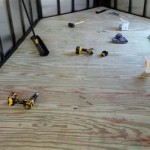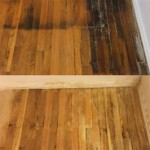Installing Engineered Hardwood Floors on Concrete: A Comprehensive Guide
Transforming your concrete subfloor with the warmth and elegance of engineered hardwood flooring requires a strategic approach and attention to detail. By following these essential steps, you can ensure a durable and captivating floor that will enhance your living space for years to come.
1. Preparation is Key
Before laying your engineered hardwood floors, it's crucial to prepare your concrete subfloor. Ensure the surface is level and moisture-free by conducting a moisture test with a meter. Install a moisture barrier or underlayment to prevent moisture from seeping into the flooring and damaging it.
2. Choosing the Right Underlayment
Selecting an appropriate underlayment is crucial for sound absorption, moisture resistance, and insulation. Cork, rubber, or foam underlayments provide cushioning, while moisture barriers protect against moisture damage. Choose an underlayment that suits your specific needs and subfloor conditions.
3. Plan Your Layout
Plan the layout of your flooring to minimize waste and ensure a visually appealing finish. Consider the direction of light, room flow, and any obstacles to determine the most effective and aesthetically pleasing layout for your space.
4. Use Proper Adhesive
Adhesive plays a vital role in the durability of your engineered hardwood floor on concrete. Choose a premium-quality adhesive specifically designed for engineered hardwood flooring on concrete subfloors. Follow the manufacturer's instructions carefully for proper application and drying time.
5. Installation Techniques
Securely fasten the engineered hardwood planks to the underlayment using a flooring nailer or stapler. Install the planks one row at a time, carefully aligning each plank to ensure a flush surface. Use a tapping block and flooring mallet to gently tap the planks into place.
6. Acclimation
Allow your engineered hardwood flooring to acclimate to your home's temperature and humidity for several days before installation. Unpack the flooring and place it in the room where it will be installed with plenty of space for air circulation.
7. Expansion Gap
Leave an expansion gap around the perimeter of the room to allow the flooring to expand and contract naturally with changes in temperature and humidity. Use spacers to maintain a uniform gap and prevent buckling.
8. Finishing Touches
Once the flooring is installed, allow the adhesive to cure completely. Trim any excess underlayment or flooring along the walls and baseboards. Install shoe molding or quarter-round along the baseboards to conceal the expansion gap and add a finishing touch.

Installing Wood Flooring Over Concrete Diy

How To Install Engineered Flooring On Concrete Adm

Installing Engineered Hardwood On Concrete Faqs Checklist

Installing Engineered Hardwood On Concrete Villagio Guide

Hardwood Over Concrete Auten Wideplank Flooring

How To Install A Glue Down Floor Diy Flooring

How To Install Lock Engineered Hardwood Flooring

Floating Engineered Hardwood

How To Install Engineered Hardwood Flooring On Concrete Doityourself Com

How To Install Lock Engineered Hardwood Flooring
Related Posts








